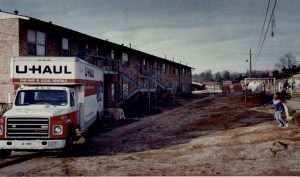
June 3rd, 2009 marked the demolition of the last public housing project in Atlanta. Bowen Homes, built in 1964 and located on the west side of Atlanta, housed almost 1,000 people and was the last large family housing project left in Atlanta until its demolition. The end of Bowen Homes marked the end of a controversial program. In turn, it started a controversial debate about Atlanta and gentrification. The Atlanta Housing Authority’s executive director hailed the demolition as an event that “marks the end of an era where warehousing families in concentrated poverty will cease.”[1] Former residents of demolished projects had a multitude of reactions: most were of hurt and confusion, with one Bowen Homes resident stating, “This is just wrong. I wish I could join in with their rejoicing. I can’t.”[2] The demolition of public housing in Atlanta created a diaspora for groups of African Americans in Atlanta. What started happening over 20 years ago in the mid-1990’s has had ramifications to this day. To fully grasp why this debate is occurring in Atlanta (and many other American cities), it is worth examining the roots of the system that was put in place; in turn, we can examine ways to avoid previous pitfalls and create safer, more equitable neighborhoods in Atlanta and beyond. What seems to be lost in this debate are human lives affected. Where do the residents go, and how are they being helped in the long term?
Atlanta is a city of transplants. People from all over have moved to “the city too busy to hate” in the last 30 years—in fact, Atlanta gained the fourth most new residents of any American city in 2017.[3] There are few traces of the former projects—if they haven’t been converted into new apartments, they have been wholly demolished. Built in 1936 and once occupying the current location of Atlantic Station, Techwood Homes was the first housing project built in America.[4] Ironically enough, Techwood Homes was built over a part of town known as The Flats, a low-income neighborhood with a sizable African American population. Hailed as an opportunity to erase slums, increase affordable housing, and improving the overall landscape of the city, Techwood Homes and the other Atlanta housing projects came to represent a failed housing policy that left people behind, and the people left behind were African American.
By the 1996, Atlanta was the first city in the United States to commence demolishing its housing projects. By that time, Atlanta had a greater percentage of residents living in public housing than any other city in the United States.[5] The demolition of the housing projects did not mean that public housing ended in Atlanta. Mixed-income communities and government-sponsored Section 8 housing were created; still, the toll on the projects’ former residents was not taken into account. Having to qualify for vouchers, find affordable housing, and often moving to only slightly less impoverished neighborhoods does not fix the problem of housing inequality. In a volatile or down economy, public housing demolitions can lead to homelessness if more low-income housing is not made available.[6] Furthermore, the vouchers provided to former residents are often looked upon with suspicion by their new landlords—the vouchers also restrict people with criminal backgrounds from obtaining them.[7] Following the demolition of the projects, a large majority of displaced residents settled in 10 of Atlanta’s poorest ZIP codes thus re-creating a cycle of poverty.[8] In fact, a 2011 Georgia State University survey found that most residents ended up in new places within, on average, only three miles of their former homes.[9]

The winners of this demolition are the contractors and investors. Once a neighborhood has gentrified, real estate values sky-rocket and money is made. At what cost? Culture has been wiped out at the expense of condos and Beltline apartments. Poor African Americans who have lived in a neighborhood their entire lives are told to pack and handed a check that will not cover a move to a safer part of town. Housing projects certainly centralized crime but to demolish them and not provide affordable housing for all merely exacerbates their original problem: legalized segregation. Conversations about gentrification and government-mandated segregated housing are finally being discussed by the mainstream. In fact, the founder of the Atlanta Beltline project recently resigned due to a belief that his project was not providing enough affordable housing and promoting inequitable gentrification.[10] What has been done at East Lake Meadows is another model that combats gentrification by preserving the neighborhood through a construction project. Realization and self-awareness by the Beltline project creator and developer Tom Cousins are what will ultimately will help those affected by gentrification. Until then, real estate will continue to take precedent over a city’s citizens.—Jeff Brown
[1] Mark Niesse, “Census: Metro Atlanta’s population approaches 5.8 million,” Atlanta Journal-Constitution, April 18, 2017. https://www.ajc.com/news/local-govt–politics/census-metro-atlanta-population-approaches-million/1pxSPBRYI6L26zn4jgVBrN/.
[2] Niesse, “Census.”
[3] Niesse, “Census.”
[4] Robbie Brown, “Atlanta Is Making Way For New Public Housing,” The New York Times, June 20, 2009. https://www.nytimes.com/2009/06/21/us/21atlanta.html.
[5] Brown, “Atlanta.”
[6] Brown, Atlanta.”
[7] Brown, Atlanta.”
[8] Brown, Atlanta.”
[9] Stephanie Garlock, “By 2011, Atlanta Had Demolished All of Its Public Housing Projects. Where Did All Those People Go?” City Lab, May 8, 2014. https://www.citylab.com/equity/2014/05/2011-atlanta-had-demolished-all-its-public-housing-projects-where-did-all-those-people-go/9044/.
[10] Leon Stafford and Willoughby Mariano, “Beltline CEO steps down; New head to focus on affordable housing,” The Atlanta Journal-Constitution, August 23, 2017. https://www.myajc.com/news/local-govt–politics/beltline-ceo-steps-down-new-head-focus-affordable-housing/RoWS3022b1qYl8eWAoBa6M/.


